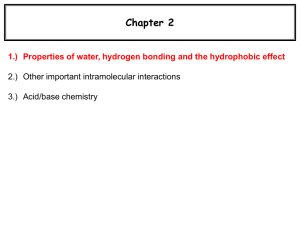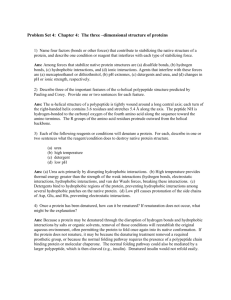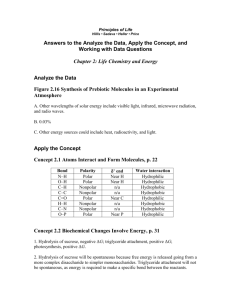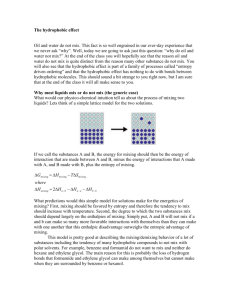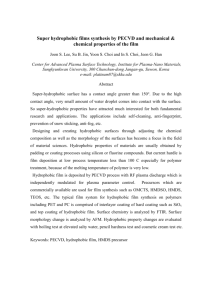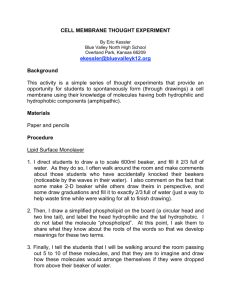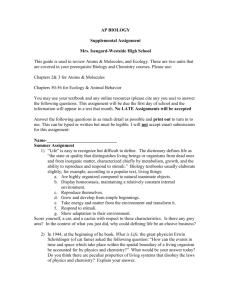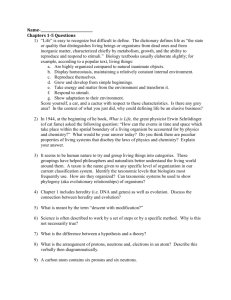The hydrophobic effect Oil and water do not mix. This fact is so well
advertisement
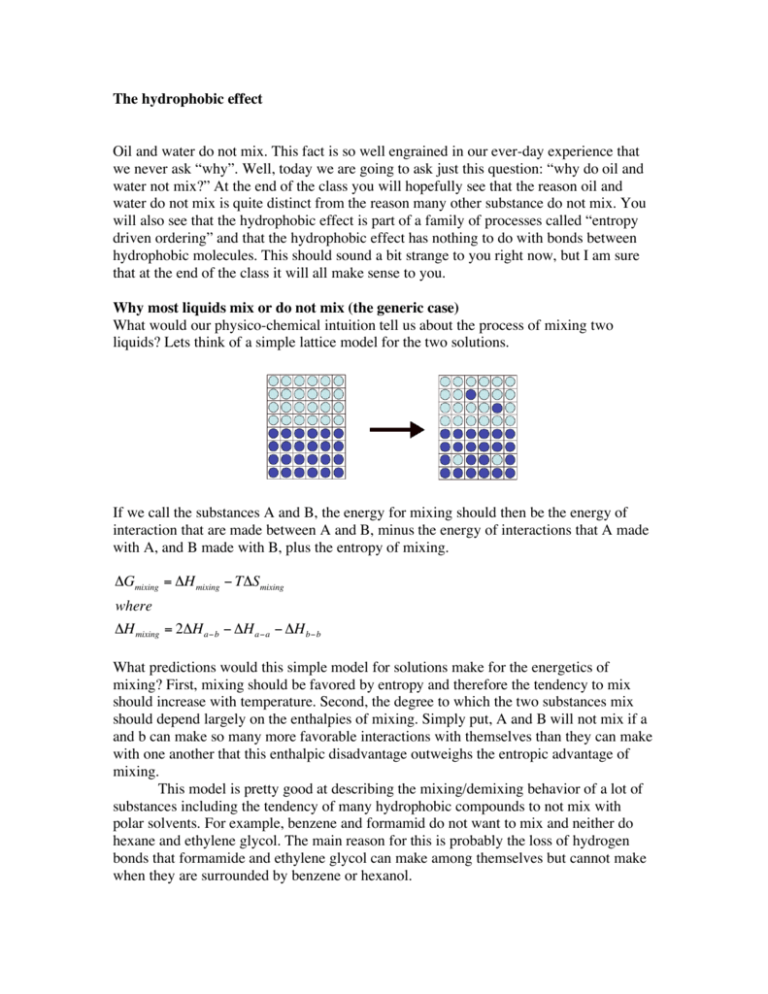
The hydrophobic effect Oil and water do not mix. This fact is so well engrained in our ever-day experience that we never ask “why”. Well, today we are going to ask just this question: “why do oil and water not mix?” At the end of the class you will hopefully see that the reason oil and water do not mix is quite distinct from the reason many other substance do not mix. You will also see that the hydrophobic effect is part of a family of processes called “entropy driven ordering” and that the hydrophobic effect has nothing to do with bonds between hydrophobic molecules. This should sound a bit strange to you right now, but I am sure that at the end of the class it will all make sense to you. Why most liquids mix or do not mix (the generic case) What would our physico-chemical intuition tell us about the process of mixing two liquids? Lets think of a simple lattice model for the two solutions. If we call the substances A and B, the energy for mixing should then be the energy of interaction that are made between A and B, minus the energy of interactions that A made with A, and B made with B, plus the entropy of mixing. "Gmixing = "H mixing # T"Smixing where "H mixing = 2"H a#b # "H a#a # "H b#b ! What predictions would this simple model for solutions make for the energetics of mixing? First, mixing should be favored by entropy and therefore the tendency to mix should increase with temperature. Second, the degree to which the two substances mix should depend largely on the enthalpies of mixing. Simply put, A and B will not mix if a and b can make so many more favorable interactions with themselves than they can make with one another that this enthalpic disadvantage outweighs the entropic advantage of mixing. This model is pretty good at describing the mixing/demixing behavior of a lot of substances including the tendency of many hydrophobic compounds to not mix with polar solvents. For example, benzene and formamid do not want to mix and neither do hexane and ethylene glycol. The main reason for this is probably the loss of hydrogen bonds that formamide and ethylene glycol can make among themselves but cannot make when they are surrounded by benzene or hexanol. While hexane and benzene are clearly hydrophobic substances and while they clearly do not want to mix with formamide and ethylene glycol, which are hydrophilic, the reason for them not mixing is not the hydrophobic effect. These compounds don’t mix, simply because they can make more favorable interactions with themselves than with the other compound. The hydrophobic effect is distinctly different from this generic de-mixing. So what then is the hydrophobic effect and how is it different from the simple tendency of two substances to not want to mix? Lets look at the data for the solubility of hydrophobic compounds in water as a function of temperature and compare this data to what we would have expected based on our simple model of mixing. "Gmixing = "H mixing # T"Smixing and ΔHmixing is independent of temperature. ! We would therefore expect the natural log of the solubility, which is the equivalent of the Keq, to increase linearly with temperature. This is clearly not what happens in the case of hydrophobic compounds and water. The solubility curve of hydrophobic compounds shows an anomalous dip in what is expected to be a straight line and this dip is just about maximal in the temperature range where proteins normally work. The difference between the generic case of two substances that do not mix and the hydrophobic effect becomes even clearer when we look at tabulated data for the solubility of hydrophobic compounds around room temperature. compound formula Benzene Toluene Ethyl benzene Prolyl benzene Pentane Cyclohexane Hexane C6H6 C7H8 C8H10 C9H12 C5H12 C6H12 C6H14 ΔG0 kcal/mol 4.62 5.47 6.27 6.91 6.89 6.73 7.78 ΔH0 kcal/mol 0.50 0.41 0.48 0.55 -0.48 -0.08 0.00 -TΔS0 (298K) kcal/mol 4.12 5.06 5.79 6.36 7.37 7.81 7.78 ΔC0 kcal/(mol*deg) 0.053 0.063 0.076 0.094 0.096 0.086 0.105 The tabulated data shows that the energetics of mixing hydrophobic compounds and water is almost the exact opposite of what we expected for simple demixing. We have enthalpies of mixing right around zero, sometimes even adopting negative values that favor mixing. While the values for the enthalpies of mixing are sort of strange, the real stunner are the values for the entropy of mixing. We would have expected entropy to favor mixing. Instead, entropy favors de-mixing; and by a lot! This entropy driven de-mixing is the central property of the hydrophobic effect. How can it be that de-mixing, which is clearly an order generating process, is driven by entropy? To answer this question we need to take a look at the molecular properties of liquid water. Liquid water forms fluctuating networks of hydrogen bonds. To understand the source of this entropy increase upon de-mixing we have to first understand how the principles of maximal entropy and minimal potential energy shape the properties of liquid water. Below are schematic pictures of water in its three forms: Ice, liquid water and steam. In ice, the principle of minimal potential energy clearly dominates; no translational or rotational entropy, but 4 perfect hydrogen bonds. At the other extreme is steam – water in its gaseous form. Here the principle of maximal entropy dominates and we will see no hydrogen bonds but maximal translational and rotational freedom. Molecular dynamics simulations of water at room temperature show water molecules assemble in small rapidly reorganizing networks, in which each water molecule forms on average 2 out of the total of 4 possible hydrogen bonds and where each molecule is on average surrounded by ~4 “nearest neighbors”. This arrangement in rapidly rearranging clusters represents an even balance between minimal potential energy and maximal entropy, it gives water a large degree of rotational, translational and vibrational entropy, but still allows water molecules to maintain, on average, half of all possible hydrogen bonds. A simple molecular model for the hydrophobic effect. To understand what happens if we add a hydrophobic solute to water we will first have a look at the conformational entropy of a water molecule in liquid water. With each water molecule surrounded by four nearest neighbors, we can approximate the geometry around each water molecule as a tetrahedron. The water molecule in the center can arrange itself in 6 different ways to hydrogen bond with two of its nearest neighbors. In the picture shown the central water forms hydrogen bonds with the water molecules at the bottom left and the bottom right. This would be the configuration that is uniquely identified by forming a triangle outlined by the two hydrogen bonds and edge number 1 of the tertrahedron. Each other edge corresponds to another unique hydrogen bonding configuration for a total of 6 possible configurations. What happens if we replace one water molecule with a solute that cannot form a hydrogen bond? Eliminating one of the edges of the tetrahedron reduces the number of possible hydrogen bonding configurations from 6 to 3. In other words, by placing it next to a hydrophobic solvent we have cut the conformational entropy of the central water molecule in half. So we can calculate the entropy loss of a solution to which we add one mol of a hydrophobic solute by determining the entropy lost by a water molecule if it goes from 6 possible hydrogen bonding conformations to 3. 0 "S 0 = Sin0 water # Son hydrophob. surface "S 0 = N A (k lnW in water # k lnW on hydrophob. surface ) "S 0 = N A (k ln6 # k ln 3) 6 "S 0 = N A k ln = N A k ln2 3 0 T"S hydrophobic = RT ln2 = 0.42kcal /mol That is 0,42 kcal/mol per water molecule. ! So the apparent attractive force driving hydrophobic molecules together in water is not an attractive force at all. Instead hydrophobic molecules stick together to minimize the area exposed to water. The less surface area is exposed the fewer water molecules have to suffer the loss of conformational entropy, the lower the energetic penalty. So the hydrophobic effect is an entropy-driven process that seeks to minimize the free energy of a system by minimizing the interface surface between hydrophobic molecules and water. The most efficient mechanism for reducing this water/hydrophobic interface is the aggregation of the hydrophobic surfaces with one another. The aggregation of hydrophobic molecules obviously represents a sort of ordering, but the entropic cost of demixing water and hydrophobic molecules is smaller than the entropic cost of ordering water molecules on the large hydrophobic-water interfaces that would be associated with the mixing of hydrophobes and water. A methyl group adds ~0.8kcal/mol to the hydrophobic effect If we use our simple model of the hydrophobic effect and data on the number of water molecules that form the first hydration shell around hydrocarbon molecules we can calculate the magnitude of the hydrophobic effect. For example, adding a new methyl group to an existing molecule adds the equivalent of ~4 waters to the molecule’s surface area. Using these numbers and our model, the entropic contribution to the hydrophobic effect computes to T"S 0 hydrophobic = m # RT ln2 = 4 # 0.42kcal /mol = 1.68 kcal /mol ! This number is obviously an overestimation because our model does not take into account the entropy lost by de-mixing the water and hydrophobes. Still the number we got from this really simple model is surprisingly close to experimental values, which are around 0.8 kcal/mol for the ΔG0 hydrophobic of adding a methyl group to an existing molecule. See for example the difference between benzene and toluene or pentane and hexane. This “rule-of-thumb” number of 0.8 kcal/mol was also determined independently by performing mutagenesis experiments on proteins (e.g. valine to isoleucine) and the 0.8 kcal/mol turns out to be correct for a large number of molecules. The hydrophobic effect is associated with low enthalpy and high heat capacity Now that we have the basic molecular picture for the hydrophobic effect, lets see if we can also understand two more features of the hydrophobic effect as well. First, why is the enthalpic contribution of the hydrophobic effect so small, sometimes even favoring mixing? The answer is that water around hydrophobic surfaces adopts a more ordered arrangement. This restricted conformational freedom of the waters favors well-ordered and tight hydrogen bonds. These well-formed hydrogen bonds are also at the core of the high heat capacity associated with the hydrophobic effect. The so-called iceberg model explains this high heat capacity with the melting of these highly efficient water cages by analogy to the high heat capacity associated with the phase-transition of ice melting in water.

